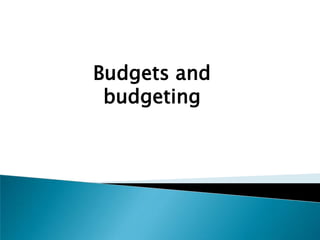
Lecture 7 budgeting
- 2. BUDGETING Generic Budgeting Systems Trade-off Between Decision Making and Control Resolving Organizational Conflicts
- 3. BUDGETING A budget is management’s forecast of revenues, expenses, and profits in the future. Knowledge: Budgets communicate key planning assumptions such as product prices, units sales, and input prices. Decision Rights: Budgets set guidelines regarding resources available for each segment. Performance Evaluation: A responsibility center’s actual performance is compared to budget.
- 4. BUDGETING Responsibility Centers: profit center or cost center. Measurement: Monthly reports compare actual revenues and expenses to budget. Budget process separates decision rights: ◦ Initiation by management. ◦ Ratification and monitoring by Board of Directors.
- 5. BUDGETING Budgets are used for both decision making and control. Decision making requires managers to reveal private knowledge about production and market conditions during budget negotiations. When budgets are used for performance evaluation, managers have an incentive to make biased budget forecasts so that their actual performance will look good relative to budget.
- 6. BUDGETING Ratchet effect: Basing next year’s budget on this year’s performance. Disadvantages: ◦ Performance targets are adjusted upward. ◦ Employees reduce output to avoid being held to higher standards in the future. Possible Solution: ◦ Eliminate budget targets. ◦ Estimate next year’s sales. ◦ More frequent job rotation.
- 7. BUDGETING Top-down budgets: Knowledge: Top management can make accurate aggregate forecasts. Decision rights: Begin with aggregate forecasts for firm, and then disaggregate down to lower levels. Control more important than decision management. Bottom-up budgets (participative budgeting): Knowledge: Lower levels have more knowledge than top. Decision rights: Person being held responsible for meeting the target makes the initial budget forecast. Decision making more important than decision control.
- 8. BUDGETING Building the budget in two steps: ◦ Step 1: Construct budgets in operational terms (Lowest levels of the organization). ◦ Step 2: Develop a financial plan based on the operational plan from Step 1. Budgets should be used for financial planning (decision making), but not for performance evaluation (control). ◦ Units should be judged by comparing their actual performance with the actual performance of defined “peer units”. ◦ Rewards can include consideration of both financial and non-financial performance measures.
- 9. BUDGETING Top executive officers of firms have final decision rights over the budget process. Top executives resolve disputes among lower levels. After adoption, the budget is an informal set of contracts among the various units of the firm.
- 10. BUDGETING Firms that use annual budgets do not create adequate incentives for long-term planning and responding to new opportunities. Strategic planning requires long-term budgets (2, 5, or 10 years). Banks often require cash flow projections for the length of any proposed borrowing. Many firms require managers to prepare both short-term and long-term budgets as part of the periodic budget review.
- 11. BUDGETING Line-item budgets authorize managers to spend up to a specified amount on each line item. Advantages: Tight control reduces opportunities for managers to take actions inconsistent with firm goals. Disadvantages: Not flexible in responding to unanticipated needs. Little incentive for cost savings.
- 12. BUDGETING An 18-month rolling budget versus a static budget. Advantages: Keeps the budget more in a changing environment. Managers may react in a more timely manner by integrating planning and execution. Disadvantages: Costs of software and management time.
- 13. BUDGETING Lapsing occurs when funds allocated for a particular year cannot be carried over to the following year. Advantages: ◦ Tighter control than budgets that do not lapse. ◦ Prevents risk-averse managers from accumulating funds. Disadvantages: ◦ Encourages wasteful spending near end of fiscal year.
- 14. BUDGETING Static budgets: ◦ Do not vary with volume. ◦ Volume changes may create budget variances. Since managers are not insulated from volume changes, they will try to mitigate the impact of adverse volume changes.
- 15. BUDGETING Flexible budgets: ◦ Adjust for changes in volume. ◦ Evaluate performance after adjusting for volume effects. Manager is not held responsible for volume changes.
- 16. BUDGETING Incremental budgeting: ◦ Begin with current year’s core budget and make incremental changes. ◦ Review focuses on incremental changes and may ignore inefficiencies in core budget. Zero-based budgeting (ZBB): ◦ Each line in budget is set to zero each year. ◦ Motivates managers to eliminate inefficient expenses. ◦ Useful when firm is changing strategic direction. ◦ Becomes less useful when same justifications are used each year.
